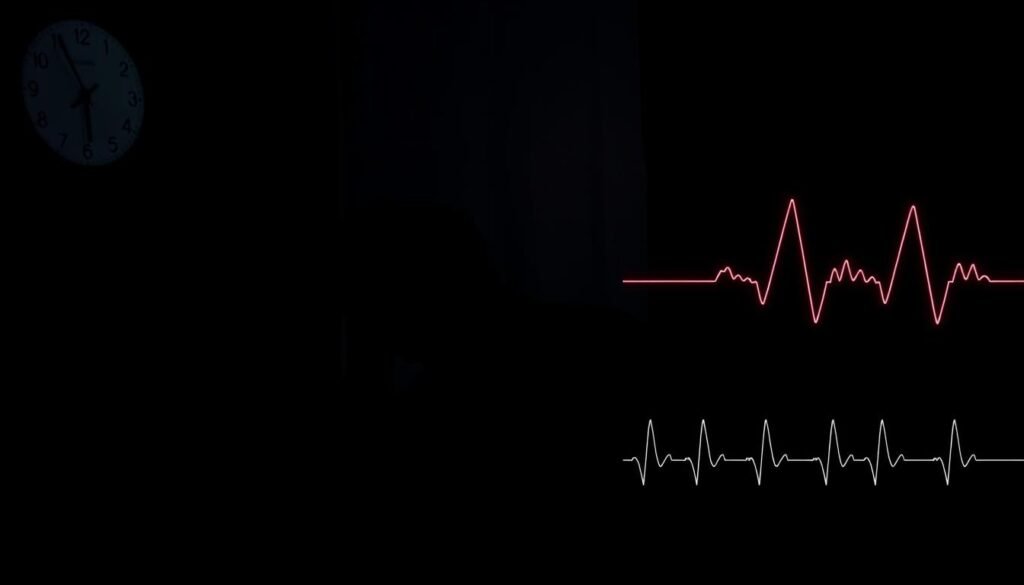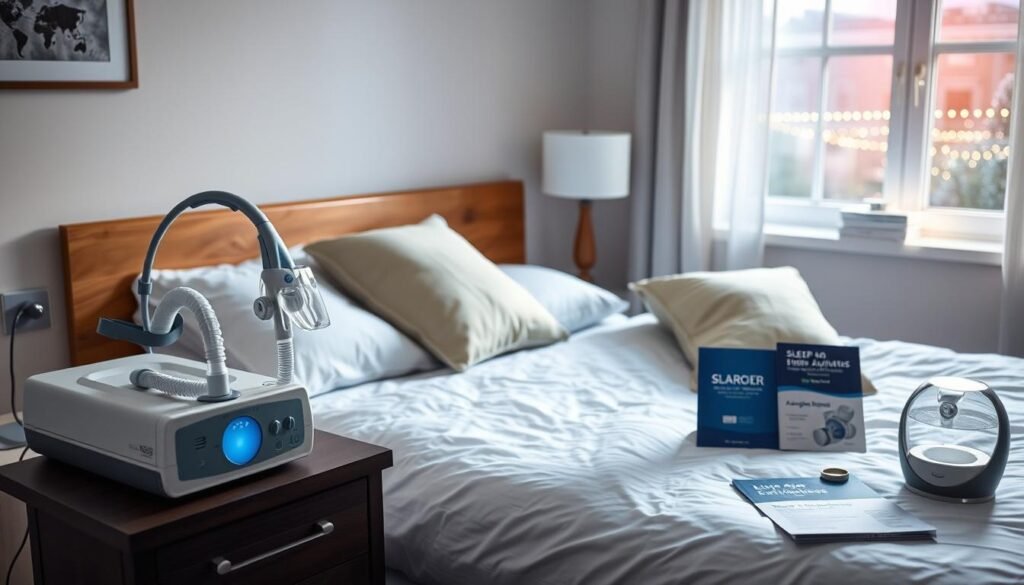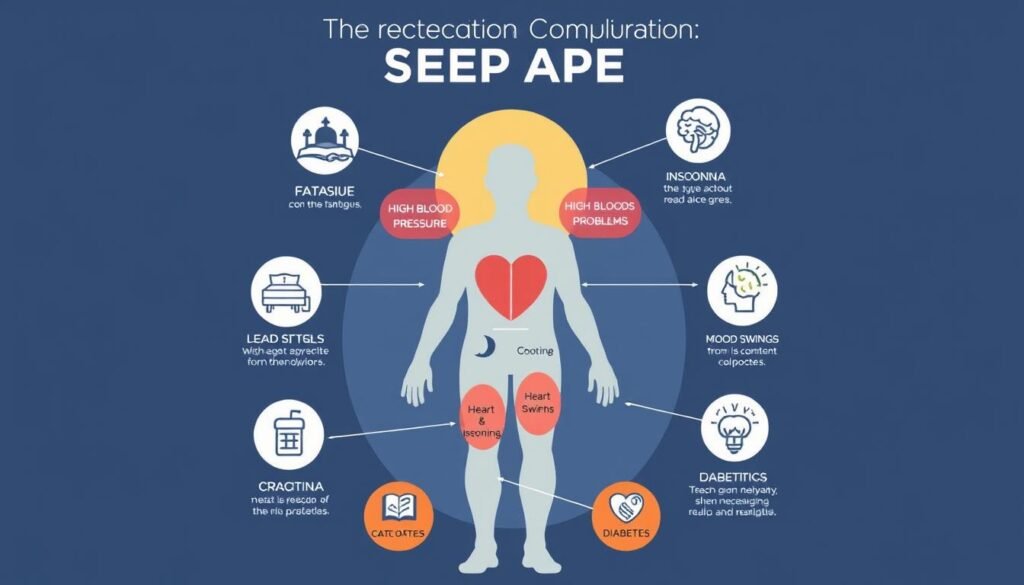Did you know sleep apnea is more common in obese people? Over 20 percent of them are affected. This is a big difference from the 3 percent in those of a normal weight. This fact shows how sleep apnea affects sleep quality and health.
Sleep apnea is a serious issue. It causes repeated breathing interruptions during sleep. This disrupts the deep, restful sleep we need. In this article, we’re diving into what sleep apnea is, its signs, causes, risks, and how to treat it. Knowing about sleep apnea means you can look after your health better. It means a better life quality.
Key Takeaways
- Sleep apnea is more common among obese individuals, affecting over 20 percent.
- Understanding sleep apnea is crucial for recognizing its health impacts.
- Effective treatment can improve overall sleep quality.
- Untreated sleep apnea can lead to serious long-term health consequences.
- Raising awareness about sleep apnea is essential for prevention and early diagnosis.
- Quality of life can drastically improve with proper management of sleep apnea.
Understanding Sleep Apnea
Sleep apnea is a serious sleep disorder that affects many people. It causes breaks in breathing while asleep. Not only does it impact sleep quality, but it can also lead to other health problems if not addressed. It’s important to know about Definition of Sleep Apnea, understand the Main Types of Sleep Apnea, and be aware of Sleep Apnea Symptoms.
Definition of Sleep Apnea
Definition of Sleep Apnea describes it as a condition where breathing stops temporarily during sleep. This lack of breathing means not enough oxygen gets to the body’s tissues. These interruptions happen many times at night, ruining normal sleep patterns and causing tiredness during the day.
Main Types of Sleep Apnea
The Main Types of Sleep Apnea include:
- Obstructive Sleep Apnea (OSA): The most common kind, seen in 10% to 30% of adults in the U.S. It happens when throat muscles relax too much and block the airway.
- Central Sleep Apnea (CSA): Not as common as OSA, affecting less than 1% of people. It occurs when the brain doesn’t send the right signals to breathe.
- Treatment-Emergent Central Sleep Apnea: This can happen in those with OSA who start treatment with positive airway pressure (PAP) therapy.
Common Symptoms of Sleep Apnea
Those with Sleep Apnea Symptoms might notice troubling signs like:
- Loud snoring
- Gasping for air during sleep
- Feeling extremely tired during the day
- Quick changes in mood
- Headaches in the morning
Being aware of these symptoms can lead to early detection and treatment of sleep apnea. This is essential for better health and a good night’s rest.
Impact of Sleep Apnea on Sleep Quality
Sleep apnea greatly disrupts how well we sleep, causing many problems for those who have it. People wake up often, missing the deep sleep needed to feel rested. This can lead to feeling tired all the time and having trouble thinking clearly.
How Sleep Fragmentation Affects Restorative Sleep
For people with obstructive sleep apnea (OSA), sleep fragmentation makes it hard to get into deep sleep. This is crucial for physical and mental recovery. The stops in breathing break up sleep, making quality rest elusive. This cycle of fatigue and irritability can seriously harm one’s quality of life. Getting the right treatment for Sleep Apnea Effects is key to better sleep and overall wellbeing.
Comparison of Sleep Quality in OSA Patients vs. General Population
Research shows a big difference in sleep quality between those with OSA and the average person. People with untreated sleep apnea feel worse off in terms of well-being and satisfaction with life. It’s crucial to get help, as good communication with healthcare providers can lead to better outcomes. For more details, see this study. The gap in Sleep Quality in OSA Patients impacts not just health, but also work and social life.
Sleep Apnea Causes
It’s key to know what causes sleep apnea to manage and treat it well. Obesity is a main cause. Being overweight, especially around the neck, can block normal airflow while sleeping. This makes sleep apnea worse. Also, a narrow airway can increase the chance of blockage.
Obesity and Its Role in Sleep Apnea
Being overweight greatly ups the risk of sleep apnea. Those heavier have more fat in the neck area. This fat can block the airway when sleeping. Losing weight, though, can really help with symptoms.
Anatomical Factors and Genetic Predisposition
Body structure and genes matter in sleep apnea causes, too. People at risk often have a narrow airway. Also, if sleep apnea runs in the family, especially in males, the risk is higher.
Other Health Conditions Associated with Sleep Apnea
Other health problems can also raise sleep apnea risk. High blood pressure, insulin resistance, or type 2 diabetes are examples. Choices like smoking can increase the risk, too. Knowing how these health issues connect to sleep apnea is key. This understanding can make treatments better. Learn more about sleep apnea causes and connected health issues for effective solutions.
Sleep Apnea Risks
Sleep apnea can seriously affect both your body and mind. Knowing the risks is vital for those who might have this disorder.
Cardiovascular Risks Linked to Sleep Apnea
Sleep Apnea Risks seriously harm heart health. It causes lack of oxygen during sleep. This can increase blood pressure, lead to heart disease, and cause strokes.
People with severe obstructive sleep apnea face major heart risks. Untreated, they’re much more likely to have car accidents from being too tired. This makes finding and treating the disorder very important.
Impact on Mental Health and Cognitive Function
The Impact on Mental Health is huge. Sleep apnea does not just harm the body. It also leads to mental issues like anxiety and depression. Over 300 million people worldwide suffer from depression, often due to poor sleep.
Not treating sleep apnea can harm your brain, causing memory issues. It can make dementia worse, affecting millions. Getting treatment can really help your mind and memory.
| Risk Factor | Impact | Statistics |
|---|---|---|
| Cardiovascular Issues | Increased risk for heart disease and strokes | Patients are 2.5 times more likely to have accidents |
| Mental Health | Heightened risk for anxiety and depression | Depression affects 300 million globally |
| Cognitive Function | Memory impairment and risk for dementia | Dementia affects over 55 million people |

Importance of Treating Sleep Apnea
Treating sleep apnea is crucial for our health. If we don’t treat it, we face serious health issues that affect how we function daily. People with sleep apnea might stop breathing up to 90 times every hour. This ruins their deep sleep.
This lack of good sleep can make you very tired, increase your blood pressure, and raise your stroke risk. Research shows people with bad sleep apnea are almost three times more likely to have high blood pressure. The risk of feeling very sad or depressed also goes up, making treatment important.
Long-Term Health Consequences of Untreated Sleep Apnea
Sleep apnea isn’t just about poor sleep; it can lead to serious health problems. The Wisconsin Sleep Cohort Study found that severe sleep apnea triples your death risk from any cause. It’s also connected to a higher chance of getting certain kinds of cancer like colorectal and breast cancer in younger men. Other health issues, like worse insulin resistance, highlight why treating sleep apnea matters for our health over time.
Quality of Life Improvement with Treatment
Treatment, especially using CPAP, greatly improves life quality. CPAP use cuts down on sleepiness during the day. It helps you stay alert and think clearly, making work or school better.
Reports say about 75% of those using CPAP feel less tired. It can also lower your risk of heart problems by reducing blood pressure. Plus, people who use CPAP are less likely to have accidents since they’re more alert.
| Health Consequence | Impact Without Treatment | Impact With CPAP Treatment |
|---|---|---|
| Hypertension | Nearly 3x greater incidence | Lower blood pressure levels |
| Risk of Stroke | 4.5x greater incidence | Reduced risk |
| Depression | 2.6x higher incidence | Potential reduction in symptoms |
| Performance and Cognition | Decreased awareness and focus | Improved memory and focus |
Sleep Apnea Treatment Options
Sleep apnea treatment relies on various tailored strategies. The main method often focuses on Positive Airway Pressure (PAP) therapy. This therapy is a key player in managing obstructive sleep apnea. It greatly improves sleep quality and overall health.
Overview of Positive Airway Pressure (PAP) Treatment
The most common way to tackle obstructive sleep apnea is the Continuous Positive Airway Pressure (CPAP) machine. This device sends air to keep airways open during sleep, preventing breathing pauses. “The Overview of PAP Treatment” covers different types, such as:
- CPAP: A standard approach that ensures open airways.
- Bilevel Positive Airway Pressure (BPAP): Adjusts pressure during breathing in and out.
- Autotitrating Positive Airway Pressure (APAP): Automatically changes pressure according to airway resistance.
Those who find CPAP uncomfortable might prefer BPAP or APAP. Both are effective.
Alternative Therapies: Lifestyle Changes and Surgery
Lifestyle changes can also play a big part in treatment success. Some easy changes include:
- Weight loss
- Regular exercise
- Positional therapy, which means sleeping on one’s side
These efforts can lessen sleep apnea symptoms, improving sleep quality.
Surgery is another option for those with structural causes of their condition. Surgeries like uvulopalatopharyngoplasty (UPPP) and maxillomandibular advancement remove excess tissue or adjust structures to clear obstructions.

Sleep Apnea Treatment Options can bring big improvements. They help reduce symptoms, boost energy, and better daily life for people dealing with this issue.
| Treatment Option | Description | Effectiveness |
|---|---|---|
| CPAP | Delivers continuous airflow to prevent airway collapse. | Gold standard, highly effective for many patients. |
| BPAP | Adjusts pressure levels for inhalation and exhalation. | Effective for patients with discomfort using CPAP. |
| APAP | Adapts pressure automatically based on needs. | Useful for those with fluctuating weight and needs. |
| Lifestyle Changes | Involves weight loss, exercise, and positional therapy. | Can significantly reduce symptoms and improve quality of life. |
| Surgery | Includes tissue removal and structural adjustments. | Provides options for those not responding to other treatments. |
Sleep Apnea Diagnosis
Getting the right diagnosis for sleep apnea is crucial. It helps doctors treat this condition better. They use different methods to check for sleep apnea and decide on the best care approach.
Common Diagnostic Methods for Sleep Apnea
Doctors use several techniques to see if someone has sleep apnea. These methods are:
- Clinical Assessments: A patient’s history and check-up are important. Doctors look for signs like snoring, sleep choking, or being very sleepy during the day.
- Polysomnography: This sleep study, done in a lab, tracks brain actions, heart beats, breathing, and oxygen levels while sleeping.
- Home Sleep Apnea Testing: Some can test their sleep at home with special devices. But, these devices might miss some sleep apnea signs.
- Questionnaires: Questionnaires like the Epworth Sleepiness Scale measure how sleepy someone feels in the day. They help spot sleep issues.
Evaluating the Severity of Sleep Apnea
The next step is to figure out how severe the sleep apnea is. This is crucial for choosing the best treatment. The Apnea-Hypopnea Index, or AHI, counts sleep disruption events per hour. It helps classify sleep apnea.
| Severity Level | Apnea-Hypopnea Index (AHI) |
|---|---|
| Mild | 5–15 events per hour |
| Moderate | 15–30 events per hour |
| Severe | More than 30 events per hour |
This system helps doctors understand the impact of sleep apnea on a patient. A good diagnosis guides treatment and predicts other health risks. It’s essential for improving the patient’s health and life quality.
Sleep Apnea Complications
Sleep apnea can seriously affect your health, more than just ruining a good night’s sleep. It can make you extremely tired during the day. This tiredness can make everyday activities hard and even dangerous, especially if you’re driving. While about 25 percent of adults might have sleep apnea, many do not know they have it. This raises the risk of facing these health issues.
Daytime Fatigue and Impaired Daily Functioning
People with sleep apnea often feel very tired during the day. Their sleep gets interrupted, preventing deep, restful sleep. This can affect their well-being and safety, making accidents more likely.
Research shows having severe sleep apnea doubles the risk of car accidents. It’s vital for both people and doctors to understand and tackle these dangers.
Potential Complications Linked to Sleep Apnea
Sleep apnea can cause serious health issues if it’s not diagnosed or treated. Some risks include:
- High blood pressure
- Type 2 diabetes
- Increased risk of heart attacks and strokes
- Metabolic syndrome, which could lead to heart disease
These problems often arise from sleep apnea-related inflammation and lowered oxygen levels. Knowing about these risks and dealing with them early is crucial. For more information, see how sleep disorders can lead to severe Sleep Apnea Complications and how treatment can help.

| Complication | Risk Factors |
|---|---|
| High Blood Pressure | Obesity, age, smoking |
| Type 2 Diabetes | Genetic predisposition, lifestyle factors |
| Heart Attack | Family history, hypertension |
| Stroke | Obstructive sleep apnea severity, age |
Raising Sleep Apnea Awareness
Increasing awareness about sleep apnea is crucial for its management and prevention. Education is key in teaching people about the symptoms and risks. Often, sleep apnea is not diagnosed because of misunderstandings. So, we need more outreach and resources focused on Sleep Apnea Awareness.
The Role of Education in Prevention
Education helps people spot sleep apnea signs and get medical help when needed. Sadly, about 80% of cases are not diagnosed. This shows the urgent need for better information. With more education, people can fight for their health. This leads to faster diagnosis and treatment.
Community Support and Resources
Community resources are key for those dealing with sleep apnea. They offer info and support networks. Many local groups hold events for sharing experiences and advice on living with sleep apnea. The Count on Sleep campaign shows how health groups can help raise awareness.
| Resource Type | Description | Availability |
|---|---|---|
| Support Groups | Meetings that provide emotional support and share treatment experiences. | Local and online |
| Educational Workshops | Sessions focused on understanding sleep apnea, its symptoms, and treatment. | Community centers, online |
| Online Resources | Websites and forums offering information and support. | 24/7 access |
Getting to community resources helps improve life for those with sleep apnea. By pushing for more Sleep Apnea Awareness and education, communities help with recognizing and managing this condition.
Conclusion
Sleep apnea greatly affects sleep quality, as many studies show. These studies reveal that up to 82% of people with sleep apnea struggle to sleep well. This can lead to more tiredness during the day and even serious health problems. It’s crucial to treat sleep apnea quickly and correctly.
It’s important to understand sleep apnea inside and out. This includes knowing its causes, signs, and the dangers tied to it. Catching it early means treatments can really help improve someone’s life. Nearly half of the people studied said they were very sleepy in the daytime. This shows we need to focus on fixing this issue to boost our overall health.
We also need to spread the word about sleep apnea and educate folks on it. Knowing the early signs and getting the right treatment can lead to better sleep. This will not only make your day-to-day life better but also improve your health over time.